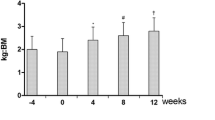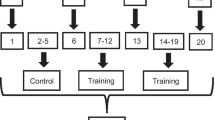Abstract
Background
The interruption of training (detraining) results in loss of the gains acquired. Partial retention could occur after detraining, and variation in training stimuli may optimize retraining adaptations.
Aim
To evaluate the effect of a resistance-retraining program on strength and functional capacity performance after a detraining period.
Methods
Ten elderly men and women (63–68 years) completed 12 weeks of training, 16 weeks of detraining, and 8 weeks of retraining. One-repetition maximum (1-RM) at 45° leg press, maximum isometric knee extension torque, rate of torque development (RTD), 30-s sit-to-stand, timed up and go, and stair ascent and descent tests were assessed.
Results
The 1-RM increased after training (p < 0.01) and remained higher after a detraining period when compared to pre-training (p < 0.01). Post-retraining values were not different from post-training period (p > 0.05). For RTD and 30-s sit-to-stand, there was an increase after retraining when compared to pre-training values (p < 0.05). For timed up and go and stair ascent and descent, reductions were observed between pre-training and post-training periods (p < 0.05), only timed up and go increased after the detraining period (p < 0.01).
Discussion
After 16 weeks of detraining, the maximum strength did not return to baseline levels, and a retraining with explosive strength exercise sessions can recover maximum strength gains, RTD, and functional capacity at the same level obtained after a detraining period.
Conclusions
The inclusion of an explosive strength session in retraining period improves RTD and 30-s sit-to-stand performance and can accelerate the recovery of strength after a detraining period.



Similar content being viewed by others
References
Ballak SB, Degens H, de Haan A et al (2014) Aging related changes in determinants of muscle force generating capacity: a comparison of muscle aging in men and male rodents. Ageing Res Rev 14:43–55
Casas-Herrero A, Cadore EL, Zambom-Ferraresi F et al (2013) Functional capacity, muscle fat infiltration, power output, and cognitive impairment in institutionalized frail oldest old. Rejuvenation Res 16:396–403. https://doi.org/10.1089/rej.2013.1438
Korff T, Newstead AH, Van Zandwijk R et al (2014) Age-and activity-related differences in the mechanisms underlying maximal power production in young and older adults. J Appl Biomech 30:12–20. https://doi.org/10.1123/jab.2013-0037
Walker S, Peltonen H, Häkkinen K (2015) Medium-intensity, high-volume “hypertrophic” resistance training did not induce improvements in rapid force production in healthy older men. Age (Omaha) 37:37–41. https://doi.org/10.1007/s11357-015-9786-9
Fhon JRS, Fabrício-Wehbe SCC, Vendruscolo TRP et al (2012) Accidental falls in the elderly and their relation with functional capacity. Rev Lat Am Enfermagem 20:927–934. https://doi.org/10.1590/S0104-11692012000500015
Viana JU, Silva SLA, Torres JL et al (2013) Influence of sarcopenia and functionality indicators on the frailty profile of community-dwelling elderly subjects: a cross-sectional study. Braz J Phys Ther 17:373–381. https://doi.org/10.1590/S1413-35552013005000102
Hartmann H, Bob A, Wirth K, Schmidtbleicher D (2009) Effects of different periodization models on rate of force development and power ability of the upper extremity. J Strength Cond Res 23:1921–1932
Moraes E, Fleck SJ, Dias MR et al (2013) Effects on strength, power, and flexibility in adolescents of nonperiodized vs. daily nonlinear periodized weight training. J Strength Cond Res 27:3310–3321. https://doi.org/10.1519/JSC.0b013e31828de8c3
Cadore EL, Izquierdo M (2013) New strategies for the concurrent strength-, power-, and endurance-training prescription in elderly individuals. J Am Med Dir Assoc 14:623–624
Correa CSC, Baroni BMB, Radaelli R et al (2013) Effects of strength training and detraining on knee extensor strength, muscle volume and muscle quality in elderly women. Age (Dordr) 5:1899–1904. https://doi.org/10.1007/s11357-012-9478-7
Correa CS, Cunha G, Marques N et al (2016) Effects of strength training, detraining and retraining in muscle strength, hypertrophy and functional tasks in older female adults. Clin Physiol Funct Imaging 36:306–310. https://doi.org/10.1111/cpf.12230
Ramírez-Campillo R, Castillo A, de la Fuente CI et al (2014) High-speed resistance training is more effective than low-speed resistance training to increase functional capacity and muscle performance in older women. Exp Gerontol 58:51–57. https://doi.org/10.1016/j.exger.2014.07.001
Holviala J, Häkkinen A, Alen M et al (2014) Effects of prolonged and maintenance strength training on force production, walking, and balance in aging women and men. Scand J Med Sci Sport 24:224–233. https://doi.org/10.1111/j.1600-0838.2012.01470.x
Pereira A, Izquierdo M, Silva AJ et al (2012) Muscle performance and functional capacity retention in older women after high-speed power training cessation. Exp Gerontol 47:620–624. https://doi.org/10.1016/j.exger.2012.05.014
Cadore EL, Izquierdo M (2013) How to simultaneously optimize muscle strength, power, functional capacity, and cardiovascular gains in the elderly: an update. Age (Dordr) 35:2329–2344. https://doi.org/10.1007/s11357-012-9503-x
Hakkinen K, Alen M, Kallinen M et al (2000) Neuromuscular adaptation during prolonged strength training, detraining and re-strength-training in middle-aged and elderly people. Eur J Appl Physiol 83:51–62. https://doi.org/10.1007/s004210000248
Peterson MD, Rhea MR, Sen A et al (2010) Resistance exercise for muscular strength in older adults: a meta-analysis. Ageing Res Rev 9:226–237
Henwood TR, Taaffe DR (2008) Detraining and retraining in older adults following long-term muscle power or muscle strength specific training. J Gerontol A Biol Sci Med Sci 63:751–758
Hasselmann V, Oesch P, Fernandez-Luque L et al (2015) Are exergames promoting mobility an attractive alternative to conventional self-regulated exercises for elderly people in a rehabilitation setting? Study protocol of a randomized controlled trial. BMC Geriatr 15:108. https://doi.org/10.1186/s12877-015-0106-0
Phillips EM, Schneider JC, Mercer GR (2004) Motivating elders to initiate and maintain exercise. Arch Phys Med Rehabil 85:52–57
Henwood TR, Riek S, Taaffe DR (2008) Strength versus muscle power-specific resistance training in community-dwelling older adults. J Gerontol A Biol Sci Med Sci 63:83–91
Zech A, Drey M, Freiberger E et al (2012) Residual effects of muscle strength and muscle power training and detraining on physical function in community-dwelling prefrail older adults: a randomized controlled trial. BMC Geriatr 12:68. https://doi.org/10.1186/1471-2318-12-68
Rhea MR, Alvar B, Burkett LN et al (2003) A meta-analysis to determine the dose response for strength development. Med Sci Sports Exerc 35:456–464
Brown LE, Weir JP (2001) ASEP Procedures Recommendation I: accurate assessment of muscular strength and power. J Exerc Physiol Online 4:1–21
Aagaard P, Simonsen EB, Andersen JL et al (2002) Increased rate of force development and neural drive of human skeletal muscle following resistance training. J Appl Physiol 93:1318–1326
Rikli RE (2000) Reliability, validity, and methodological issues in assessing physical activity in older adults. Res Q Exerc Sport 71:S89–S96. https://doi.org/10.1080/02701367.2000.11082791
Moura BM, Sakugawa RL, da Orssatto LB et al (2017) Functional capacity improves in-line with neuromuscular performance after 12 weeks of non-linear periodization strength training in the elderly. Aging Clin Exp Res. https://doi.org/10.1007/s40520-017-0873-x
Rhea MR (2004) Determining the magnitude of treatment effects in strength training research through the use of the effect size. J Strength Cond Res 18:918–320. https://doi.org/10.1519/14403.1
Fatouros IG, Kambas A, Katrabasas I et al (2005) Strength training and detraining effects on muscular strength, anaerobic power, and mobility of inactive older men are intensity dependent. Br J Sports Med 39:776–780. https://doi.org/10.1136/bjsm.2005.019117
Yasuda T, Fukumura K, Sato Y et al (2014) Effects of detraining after blood flow-restricted low-intensity training on muscle size and strength in older adults. Aging Clin Exp Res 26:561–564. https://doi.org/10.1007/s40520-014-0208-0
Aagaard P (2003) Training-induced changes in neural function. Exerc Sport Sci Rev 31:61–67
Maffiuletti NA, Aagaard P, Blazevich AJ et al (2016) Rate of force development: physiological and methodological considerations. Eur J Appl Physiol 116:1091–1116. https://doi.org/10.1007/s00421-016-3346-6
Rikli RE, Jones CJ (2013) Development and validation of criterion-referenced clinically relevant fitness standards for maintaining physical independence in later years. Gerontologist 53:255–267. https://doi.org/10.1093/geront/gns071
Smith WN, Del Rossi G, Adams JB et al (2010) Simple equations to predict concentric lower-body muscle power in older adults using the 30-second chair-rise test: a pilot study. Clin Interv Aging 5:173–180
Toraman NF, Ayceman N (2005) Effects of six weeks of detraining on retention of functional fitness of old people after nine weeks of multicomponent training. Br J Sports Med 39:565–568
Taaffe DRD, Henwood TTR, Nalls MMA et al (2009) Alterations in muscle attenuation following detraining and retraining in resistance-trained older adults. Gerontology 55:217–223. https://doi.org/10.1159/000182084
Author information
Authors and Affiliations
Corresponding author
Ethics declarations
Conflict of interest
On behalf of all the authors, the corresponding author states that there is no conflict of interest.
Ethical approval
Ethical approval was obtained from the local Human Research Ethics Committee (CAAE: 25995714.0.0000.0121), and the protocol was written in accordance with the standards set by the Declaration of Helsinki.
Informed consent
Informed consent was obtained from all individual participants included in the study.
Rights and permissions
About this article
Cite this article
Sakugawa, R.L., Moura, B.M., Orssatto, L.B.d.R. et al. Effects of resistance training, detraining, and retraining on strength and functional capacity in elderly. Aging Clin Exp Res 31, 31–39 (2019). https://doi.org/10.1007/s40520-018-0970-5
Received:
Accepted:
Published:
Issue Date:
DOI: https://doi.org/10.1007/s40520-018-0970-5




